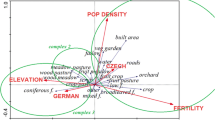Abstract
Archaeobotanical remains of a settlement mound in the Sahel zone of Burkina Faso have been investigated. The remains are charred, date to c. 1000 BP. and have provided information on the subsistence strategy of the medieval population and their impact on the environment. Apart from cultivated crops, such as Pennisetum americanum, the main staple, and pulses, the seeds and fruits of woody plants were gathered and used on a large scale. The results are interpreted as evidence for agroforestry and demonstrate the antiquity of this type of sustainable land management system.
Access this chapter
Tax calculation will be finalised at checkout
Purchases are for personal use only
Preview
Unable to display preview. Download preview PDF.
Similar content being viewed by others
References
Albert, K. D., Andres, W. and Lang, A. (1997). Palaeodunes in NE Burkina Faso; pedo-and morphogenesis in a chronological framework provided by thermoluminescence. Zeitschrift für Geomorphologie, Neue Folge 41 (2), 167–182.
Aubréville, A. (1950). Flore Forestière Soudano-Guinéenne. Paris: Société d’éditions géographiques, maritimes et coloniales.
Barth, H. (1857/58). Reisen und Entdeckungen in Nord-und Central-Afrika 4: 1849–1855.
Gotha: Justus Perthes. Becker, B. (1983). The contribution of wild plants to human nutrition in the Ferlo (northern Senegal). Agroforestry Systems 1, 257–267.
Bergeret, A. and Ribot, J. C. (1990). L’Arbre Nourricier en Pays Sahélien. Paris: Ministère de la Coopération et du Développement et la Fondation de la Maison des Sciences de l’Homme.
Brunken, J., Wet, J. M. J. de, and Harlan, J. R. (1977). The morphology and domestication of pearl millet. Economic Botany 31, 163–174.
Burkill, H. M. (1985). The Useful Plants of West Tropical Africa 1: Families A-D. London: Royal Botanic Gardens, Kew.
Burkill, H. M. (1994). The Useful Plants of West Tropical Africa 2: Families E-1. London: Royal Botanic Gardens, Kew.
Burkill, H. M. (1995). The Useful Plants of West Tropical Africa 3: Families J-L. London: Royal Botanic Gardens, Kew.
Dalziel, J. M. (1937). The Useful Plants of West Tropical Africa. London: The Crown Agents for the Colonies. FWTA (1954–1972). Flora of West Tropical Africa, 2nd edn. London: Crown Agents for Overseas Governments and Administrations.
Gibbon, D. and Pain, A. (1985). Crops of the Drier Regions of the Tropics. London: Longman.
Guinko, S. (1984). Végétation de la Haute Volta. Thèse. Université de Bordeaux.
Harlan, J. R. (1971). Agricultural origins: centers and noncenters. Science 174, 468–474.
Harlan, J. R. (1989). Wild-grass harvesting in the Sahara and Sub-Sahara of Africa. In ( D. R. Harris and G. C. Hillman, eds.) Foraging and Farming: The Evolution of Plant Exploitation. London: Unwin Hyman, pp. 79–98.
Klee, M. and Zach, B. (this volume). The exploitation of wild and domesticated food plants at settlement mounds in north-east Nigeria ( 1800 cal BC to today). In (M. van der Veen, ed.) The Exploitation of Plant Resources in Ancient Africa. New York: Plenum Press.
Krings, T. (1991). Kulturbaumparke in den Agrarlandschaften Westafrikas–eine Form autochthoner Agroforstwirtschaft. Die Erde 122, 117–129.
Kusserow, H. (1994). Quantitative und qualitative Erfassung von Vegetationsänderungen: Ein Beispiel aus dem Südsahel Malis. Die Erde 125, 35–56.
Lewicki, T. (1974). West African Food in the Middle Ages, according to Arabian Sources. London: Cambridge University Press.
Laclavère, G. et al. (1993). Atlas du Burkina Faso. Paris: Les Editions Jeune Afrique.
Manshard, W. and Mäckel, R. (1995). Umwelt und Entwicklung in den Tropen: Natwpotential und Landnutzung. Darmstadt: Wissenschaftliche Buchgesellschaft.
Maydell, H. J. von (1983). Arbres et Arbustes du Sahel. Leurs Caractéristiques et leurs Utilisations. Eschborn: Deutsche Gesellschaft für Technische Zusammenarbeit.
Neumann, K. (this volume). Early plant production in the West African Sahel - new evidence. In (M. van der Veen, ed.) The Exploitation of Plant Resources in Ancient Africa. New York: Plenum Press.
Neumann, K., Kahlheber, S. and Uebel, D. (1998). Remains of woody plants from Saouga, a medieval West African village. Vegetation History and Archaeobotany 7. 57–77.
Pélissier, P. (1980). L’arbre dans les paysages agraires de l’Afrique Noire. Cahiers ORSTOM, série Sciences Humaines 17 (3–4), 131–136.
Steele, W. M. (1976). Cowpeas. In ( N. W. Simmonds, ed.) Evolution of Crop Plants. London, New York: Longman, pp. 183–185.
Sturm, H. J. (1997). Nutzbäume in der westafrikanischen Savanne: Der Schibutterbaum (Vitellaria paradoxa Gaertn. f.)–Charakterbaum der Sudanzone. Der Palmengarten 61 (1), 41–48.
Tubiana, M. J., and Tubiana, J. (1977). The Zaghawa from an Ecological Perspective. Rotterdam: Balkema.
Vogelsang, R. (1995). Recherches archéologiques concernant l’histoire de l’occupation de la région sahélienne au nord du Burkina Faso: Campagne de fouille de 1994. Nyame Akuma 44, 16–20.
Vogelsang, R. (1996). Continuation des recherches archéologiques au nord du Burkina Faso: Campagne de 1995. Nyame Akuma 46, 6–10.
Willerding, U. (1991). Präsenz, Erhaltung und Repräsentation von Pflanzenresten in archäologischem Fundgut. In ( W. van Zeist, Wasylikowa, K., and K. E. Behre, eds.) Progress in Old World Palaeoethnobotany. Rotterdam: Balkema, pp. 25–51.
Author information
Authors and Affiliations
Editor information
Editors and Affiliations
Rights and permissions
Copyright information
© 1999 Springer Science+Business Media New York
About this chapter
Cite this chapter
Kahlheber, S. (1999). Indications for Agroforestry. In: van der Veen, M. (eds) The Exploitation of Plant Resources in Ancient Africa. Springer, Boston, MA. https://doi.org/10.1007/978-1-4757-6730-8_9
Download citation
DOI: https://doi.org/10.1007/978-1-4757-6730-8_9
Publisher Name: Springer, Boston, MA
Print ISBN: 978-1-4419-3316-4
Online ISBN: 978-1-4757-6730-8
eBook Packages: Springer Book Archive




